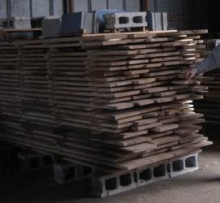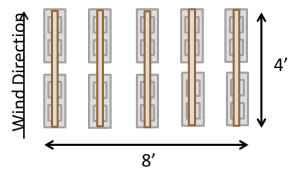Once your log has been milled, the next step is to dry the lumber. Green wood can have an Moisture Content (MC) ranging from 30% to near 200% depending on the wood species. Most of the harvestable wood in Northern Alabama has an MC between 30% and 90%. Formulas for determining the MC in wood are based on mass, with the MC given as a percent.
There are two basic methods for drying your lumber: Air Drying and Kiln Drying. With either method, you will need stickers to separate the lumber stacks, which permits air to pass between the top and bottom of each piece of lumber. Stickers are narrow lengths of dry wood, usually 1″ to 1.5″ thick and long enough to accommodate the depth of your wood pile.
Air Drying
In air drying, you stack the lumber so that air can pass through the stack and circulate around the lumber, wicking away the moisture over time. Air drying is slower because it is dependent on three environmental factors.
Air Drying factors:
- Air movement
- Ambient temperature
- Relative humidity
Air drying can reduce the MC to between 13% and 20% in an outside yard. To further reduce the MC requires that the wood be moved indoors. Air drying is slow but cheap and it is the way our ancestors dried wood for hundreds of years.
Kiln Drying
Kiln Drying requires some kind of solar, electrical, or mechanical enclosure that controls the heat, air movement, and relative humidity. These can be huge, high-cost professional kilns, a homemade solar kiln, or something in between. It really depends on what you are willing to spend, how fast you want the wood dried, and the amount of lumber you need to dry at one time.
Kiln drying requires an understanding of the nature of the wood you are drying. Drying too fast or too hot can damage your lumber. The big advantages to kiln drying are the reduction in time from milling to building and the ability to kill insect larva that may be in the lumber.
The downside of this method is the expense of the kiln, the space that it consumes, and the fact that all wood moisture content adjusts to the relative humidity of its environment regardless of how it was dried.
Stacking Lumber for Drying
I cut most of my lumber in 9’ lengths. To set up for a drying stack of 9’ lumber, I lay out cinder blocks 2’ on center to cover 8’. I place the second set 4’ measuring outside to outside. Then I lay 4’ landscaping timbers as shown in Figure A. For 10′ lumber, add another row of cinder blocks.
Next, I lay a sticker on each timber. Stickers need not measure more than an 1 1/2” by 3/4” and must be thoroughly dry. I started my stock of stickers by ripping old 2 x 4s.
To place the first layer of wood, I overhang about a 6” on each side. Each layer should have a gap between the board to allow air flow up and down. The stickers in next and subsequent layers must line up directly on top of the sticker below it to prevent warping. Last, I cover the top to prevent direct rain on the stack, leaving the sides open.
All lumber will check (split) on the ends as a part of the drying process. There are products that can be used to reduce the checking but they tend to mess up the plane so you will have to cut the end off anyway. I just cut my lumber a foot longer than needed to allow for the checking.

